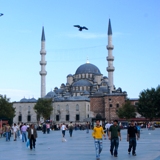
Hirami Ahmet Paşa Camii, Fatih, İstanbul, Hirami Ahmet Pasha Mosque, Pentax K10d
Hirami Ahmet Pasha Mosque (Turkish: Hirami Ahmet Pasa Mescidi) is a former Eastern Orthodox church converted into a mosque by the Ottomans. The small church, one among the 36 dedicated to Saint John the Baptist in Constantinople, was part of a monastery bearing the same name. Its full name was Saint John the Forerunner by-the-Dome (Hagios Ioannis ho Prodromos en to Trullo). It is the smallest Byzantine church of Constantinople still extant and has never been studied.
The building lies in Istanbul, in the district of Fatih, in the neighborhood of Çarsamba, one of the most (Islamic) conservative areas of the walled city. It is located in Koltutçu Sokak, along a small square, surrounded by new buildings, less than 400 m to the south of the complex of the Pammakaristos.
Nothing is known about this church before the conquest of Constantinople in 1453. The appellation “troullos” (Latin trullus, Italian trullo, dome) probably comes from a dome-roofed palace that used to be in the neighborhood. According to its style, the church must have been built during the 12th century.
Between 1454 and 1456, when the Patriarchate was moved from the Church of the Holy Apostles to that of Pammakaristos, Patriarch Gennadios displaced some nuns who were living in the monastery of Pammacharistos to the small nunnery of Troullos, which probably was founded in this occasion. At the end of 16th century, during the reign of Sultan Murat III, Hirami Amet Pasha, formerly Agha of the Jannissaries, converted the church of the Pammakaristos into a mosque. He did the same with the church of Saint John, closing the nunnery and expelling the nuns. This should have occurred between 1587/88 (the years of the conversion of Pammakaristos) and 1598, the year of his death. At the beginning of the 20th century, the small building went to ruin. In 1961, it was carefully restored and reopened to Islamic worship

Hirami Ahmet Paşa Camii, Fatih, İstanbul, Hirami Ahmet Pasha Mosque, Pentax K10d
The building is built of masonry made with bricks and stone. It has a cross-in-square plan surmounted by a dome, with a bema divided in three parts and a narthex. It is only 15 m long, included the narthex. The arms of the cross to the north and south are covered with barrel vaults, and the interior is lighted by triple windows. Four columns with capitals sustain an octagonal drum, which bears the dome. The three apses are semicircular. The central apse projects outside, and is opened by a large window, divided in three parts by two pillars with capitals. The diaconicon has been reused as mihrab of the mosque. The prothesis is surmounted by a barrel vault. The mosque has no minaret.
Before restoration, the building was in a very bad condition: the narthex was almost completely ruined, the columns had disappeared, and the paintings were barely visible. The four missing columns have been replaced with ancient ones, whose origin is unknown. The edifice has never been the subject of a systematic study.

Hirami Ahmet Paşa Camii, Fatih, İstanbul, Hirami Ahmet Pasha Mosque, Pentax K10d
.

Hirami Ahmet Paşa Camii, Fatih, İstanbul, Hirami Ahmet Pasha Mosque, Pentax K10d








Thank you once more for your detailed information with historical background about your hometown Istanbul.
Are there some pictures from inside the Hirami Ahmet Pasha Mosque? I’m some curious…
My wife and I usually travel to Turkey (we use Istanbul as a home-base), several times a year. These are great pictures of this mosque; we’ve not visited it, but now we will. Thanks for the historical background. I always appreciate such detailed information!